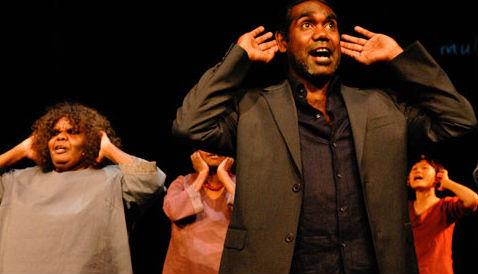Theatre that changes lives needs to make the invisible visible.
‘Nations are narrations…’ (Edward W Said)
Outsiders in society often find themselves invisible to their communities. Because they are invisible they are often clumsily damaged, disadvantaged or ignored. Ending invisibility is not as simple as allowing their story to be heard, and they are often invisible for a complex variety of reasons.
But the first step towards the protective safety of being a visible part of the community is for their story to become a part of our collective narrative. And an outsider’s story, when told with virtuosity, will be more easily accepted and embraced. This story-telling will come in many different forms, genres, platforms, carrying a different significance for different kinds of audiences, however when dealing with issues of invisibility, story – and its protective role – requires concentrated and diligent artistry and community process.
For people who find themselves outside the narrative, or demonized within it, sometimes the only thing they have left is their story. This story can often carry something of value to the broader culture within it. Something prophetic. Something that, through the telling enhances the whole of society and calls for a response that makes us all more civil. In this way their story, if told with artistic nuance has a valued currency in their local community. And sometimes this currency can provide a non-welfare pathway out of invisibility and dependency.
In this context making art, or telling one’s story is not motivated by a desire to build a career in that field, rather it may be used to create a new opportunity for belonging, taking action, experiencing visibility, making a contribution as an educator, learning skills, enjoying ordinary hospitality in your own community etc.
However this storytelling can involve professional artists, working at full stretch to bring their skills to ending the invisibility, and the work created can be of national significance, with an experimental voice and with a place in National Arts forums such as festivals. Because of the creative process and the authentic origin of the story, the work may develop a unique and powerful voice, with new literacies that challenge the jaded pallet of the viewer with new forms of expression and layers of authenticity.
To achieve this however requires a new range of skills and virtuosity from the artists involved. It required being more diligent in avoiding compromise and mediocrity than when working with more mainstream stories in well resourced contexts. It means bringing curatorial vision to the work and learning new ways of seeing and expressing that may need to come from a lower skill base. It’ll mean avoiding the slide towards easy didacticism, or at least subverting didacticism and re-presenting it in new forms etc, etc, etc… nice work if you can get it. (More at Vivid… unless we talk about something else entirely.)
Big hART will present a session on The Making of Transformative Theatre at the Vivid Ideas Festival.
9pm, Mon 27 May
The Forum, MCA, The Rocks.





